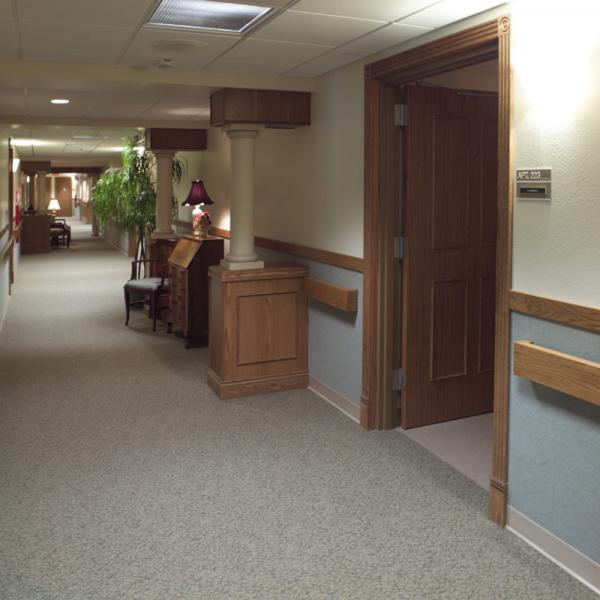8 budget-friendly tips for renovating your LTC facility
When it comes to renovation, it’s important to carefully plan for both the look and feel and the building’s performance, while sticking within an approved budget. By having a laser-like focus on areas that are sure to make a difference, you can make some drastic improvements without breaking the bank. Here are some suggestions based on the experiences my firm, Hoffman LLC, has encountered on renovation and restoration building projects.
1. Create community in multiuse spaces.
One benefit that is worth seeking with any renovation is opening up the facility. By removing walls and developing an open environment, you provide better lines of sight and increase the amount of daylight in corridors. This immediately offers a healthier environment for residents. By incorporating half-walls and enlarged openings, residents are provided with spaces that are more inviting, therefore encouraging interaction and creating a greater sense of community. Another benefit is added circulation within the spaces, providing for flexibility in furniture layouts while making access easier.
At St. Elizabeth Convent, Tampa, Fla., walls were removed to provide an open feel and create larger community spaces. Photo courtesy of Hoffman LLC. |
Another way to encourage community living is to create destinations such as a bistro or café. Consider relocating administrative-related offices and storage rooms to more back-of-house locations. Then you can remodel to increase other community gathering spaces, such as a library or parlor. This not only provides more opportunity for residents, but also aids in your marketing efforts.
2. Simple finishes freshen spaces and moods.
When it comes to updating finishes, think about how the colors will affect the mood and feel of the area. We have all seen color palettes that have come and gone, while at the same time witnessed what a simple coat of paint can do. Using color can aid in wayfinding for residents with dementia. The right colors can provide a calming environment or stimulate residents, while accent walls designate a destination space. A fresh paint job is probably the most cost-effective way to freshen up a facility and brighten resident moods.
And, since you are improving your facilities’ environment, protect your new investment. Installing corner and wall guards reduces damage and minimizes ongoing maintenance. Durable wall coverings can help with damage to drywall from carts and wheelchairs. Contemplate refinishing existing wood doors and millwork. When freshening up paint colors, think about using the handrail/chair rail to provide different shades of color from bottom to top in order to break up corridors and make them more visually interesting.
Always be sure to use low- or zero-VOC (volatile organic compounds) paint and adhesives for all finishes. You’ll not only be creating a brighter look, but a healthier environment for your residents and staff. Sustainable “green” products are becoming a standard in the industry because they just make good sense.
3. Find the right flooring.
Flooring options have increased dramatically. In recent years, carpet containing recycled content in both the fibers and the backing is common in today’s market place and is also affordable. Many manufactures offer varying styles and color palettes, providing endless options. Be mindful of where carpeting is to be placed as vinyl-backed carpets, although more costly, are a necessity in areas prone to incontinence accidents and food spills. In addition to style and practicality, carpet and carpet borders can also facilitate wayfinding by creating pathways throughout the property.
Leasing carpet is a unique idea in floor covering whereby carpet suppliers, for a monthly fee, maintain the carpet for the life of the lease. This option results in a reduced initial cost and the carpet is often recycled at the end of its lease period. Another way to reduce financial risk is to install carpet tiles. Environmentally friendly carpet tiles come in an array of sizes and can easily be replaced when damaged or when stains destroy an area.
But, carpet isn’t the only option. Providing a high-quality wood appearance can be accomplished with a cost-effective sheet vinyl, or even vinyl planks. Be certain to use darker grout colors when updating tile floors and walls in bathing and toilet rooms to reduce future maintenance expenses. Lighter colors tend to get dirty over time, resulting in the need for extensive cleaning and/or sealing. Identifying your intended use of the spaces and your maintenance program will determine the appropriate flooring to use throughout the facility.
4. Focus on resident-friendly furniture.
No matter how much you renovate your facility, if you retain the same furniture, you’ll lose some of the “pop." Be especially audience-centric when choosing new furniture for your residents. It is essential to choose age-appropriate furnishings, which provide firm seating and greater ease of getting in and out. Most importantly—don’t forget the arms! Be certain to provide various sizes along with a variety of chair types such as wing chairs, rockers (with lock-out options), and shallow-depth couches/love seats to accommodate the spectrum of guests you serve. Consider power-lift chairs to encourage those with more severe limitations to congregate with others. In dining rooms, casters on the front legs make it easier to pull the chair out and scoot it forward when sitting. Fabrics that are appropriate to protect from spills and accidents are worth the slight premium to protect your investment.
 |
Flooring that reduces glare helps create a home-like environment. Updated finishes and lighting define destinations along a route. Photo by Weston Imaging Group; courtesy of Hoffman LLC. |
5. Win with warmth.
There are a variety of features to consider that create a homelike feel, while still providing for the health and safety of the variety of residents you serve. Country-style kitchens with wood cabinets and low counters provide comfort and familiarity. Offering intimate seating areas with electric fireplaces creates an inviting environment for both residents and visitors. Deinstitutionalize staff areas by moving nursing stations to the back of the house. Create community spaces that are conducive to conversations, games and a variety of uses. We’ve all heard the phrase, “Home is where the heart is,” so remember to choose pictures, plants and updated window treatments that will create an inviting residential environment.
6. Fixtures and equipment are important updates.
The reality of operating a care facility is the ongoing utility and maintenance costs associated with outdated fixtures and mechanical equipment. Updating and replacing existing heating and cooling equipment with more efficient units can not only provide for better comfort for residents and staff but can also help reduce utility costs. Updating light fixtures on ceilings and walls modernize the look of the property, provide more appropriate lighting for the functionality of the setting and enhance energy efficiency. Updated plumbing fixtures provide similar opportunities for improving water efficiency and functionality.
Upgrade the quality of lighting while reducing associated energy costs by carefully considering both fixture and lamp options. One of the first considerations is to look for ways to increase the amount of daylight complemented by fluorescent fixtures that consume less energy. Watch for excessive general lighting that can be reduced, and offer high-quality task lights. Providing specific lighting levels based on the different activities conducted in each area is vital with the option to vary light levels in multiuse spaces. For instance, an activity room might be used for both exercise and crafts. While craft activities typically require strong lighting for hand-eye coordination, exercise classes can be held in a softer lighting environment while still providing the necessary contrast for aging eyes.
Many types of bathroom fixtures can reduce water consumption. Low-flow toilets, urinals, sinks and showers can be coupled with control devices to provide efficient "no-hands, no-touch" controls that minimize water use while also promoting better sanitary measures.
7. Create visual connection to the great outdoors.
A host of benefits await those who usher in a stronger link to the outdoors, enhancing the lives of staff, residents and guests. Strategically replaced windows and carefully considered landscaping are two methods that are sure to bring great dividends.
Many advances in technology have been made to windows that enhance their abilities to manage heat gain or loss and offer lighting without sacrificing efficiency. Consider adding tinted film to improve an existing window’s capacity to offer lighting and views, without negatively impacting the room temperature. When it comes to designing your landscape plan, consider raised planting beds, water features, walking paths with places to rest, and gazebos or patios for conversing or just soaking in the fresh air and sunshine.
8. Change more than just the property.
While a property renovation will automatically impact the staff and residents’ surroundings, it’s also an opportunity to change the culture for both. Changes to the dining and activity areas can make them more open for staff observation and more inviting to residents, thus improving their daily routines of living. Be strategic and you’re likely to find you’ll renovate attitudes while rejuvenating your facility.
These are some of the many modest facility enhancements that can help to deinstitutionalize an environment and create a warm, homelike space. Breaking the mold of the medical model without breaking your budget is an achievable goal for any existing building. Understanding where your facility can get its biggest bang for your budget will be crucial in determining which improvements are pursued in order to improve your residents’ experience and keep you competitive in the marketplace.
Julie Heiberger is a project architect for Hoffman LLC. Her expertise centers on designing sustainable senior living facilities. A Leadership in Energy and Environmental Design (LEED®) Accredited Professional, Heiberger is a member of the American Institute of Architects and the National Council of Architectural Review Boards. Go to www.hoffman.net for more information.
I Advance Senior Care is the industry-leading source for practical, in-depth, business-building, and resident care information for owners, executives, administrators, and directors of nursing at assisted living communities, skilled nursing facilities, post-acute facilities, and continuing care retirement communities. The I Advance Senior Care editorial team and industry experts provide market analysis, strategic direction, policy commentary, clinical best-practices, business management, and technology breakthroughs.
I Advance Senior Care is part of the Institute for the Advancement of Senior Care and published by Plain-English Health Care.
Related Articles
Topics: Articles , Design












